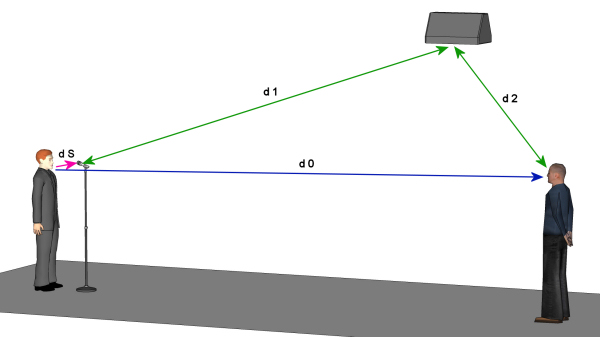
The potential acoustic gain is the amount of gain before feedback that can be obtained in a sound reinforcement system. It is based on the number of open microphones and the different distances within the system.
(Attention: the calculation is based on a basic system with omnidirectional microphones and omnidirectional loudspeakers and no room acoustics!)

d 1 = Distance between microphone and loudspeaker
d 2 = Distance between the loudspeaker and the furthest listener
d 0 = Distance between the source and the furthest listener
d S = Distance between the source and the microphone
The Potential Acoustic Gain equation is based on the Inverse Square Law:
PAG = 20 log (d1) - 20 log (d2) + 20 log (d0) - 20 log (dS) - 10 log (NOM)
PAG = Potential Acoustic Gain
NOM = Number of open microphones
Practically seen, the Potential Acoustic Gain is the difference between the unamplified sound level and the maximum level that can be achieved.
For instance: the maximum reinforced sound level is 80 dB and the level of the unamplified signal is 60 dB, then the PAG is 20 dB.
(The source for the unamplified signal is the same as the source for the microphone.)
A system with a calculated PAG under 10dB will not work properly, values between 10dB and 30dB are good.
If the reinforced sound arriving at the microphone exceeds the original sound from the talker at the microphone, the system will produce acoustic feedback.
The closer the loudspeaker is to the microphone, or the farther away the talker is from the microphone, the lower the PAG of the system will be.
Also, the further the listener is from the loudspeaker, the lower the PAG is.
The PAG calculation can give only a rough estimation!!